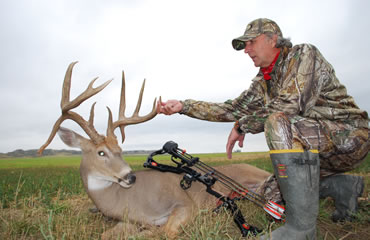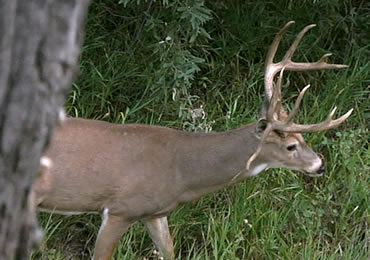When things are going about as bad as they can, a big buck might be just around the corner.
Few hunts go perfectly, so most of us learn to deal with life’s interesting twists and turns while pursuing whitetails. Sometimes, though, it seems like everything is working against you.
The one good thing about rock bottom is there’s only one direction to go. Jackie Bushman’s one and only trip to the stand in Montana in 2010 is a perfect example.
Jackie usually kicks off hunting season with a Montana bowhunt. With the Buckmasters Expo taking place in late August every year, he routinely skips the first week of the season to recover and let the Montana weather cool down before he heads out.
That was the plan last year until he got an interesting phone call.
“Jackie, I think you might want to get out here as soon as you can,” said Buckmasters cameraman Jimmy Little. “We’ve been seeing some giant bucks, and there’s a double drop-tined monster that’s been doing the same thing a few days in a row.”
Jimmy and fellow cameraman Chris Chastain had been in Montana on an antelope hunt. Having tagged out early, they decided to spend a few days scouting the property where Jackie hunts whitetails.
“I could tell they were excited,” Jackie said. “The big difference last year from any of the other 30 years or so that I’ve been hunting there was rainfall. Montana’s average rainfall is only 12 inches, but they had already gotten 18 or 20 by hunting season, and it made a big difference in the bucks’ antlers. The bucks were probably 15 to 20 inches bigger than normal, and Chris and Jimmy had seen several giants. In addition to the double drop-tined buck, they saw another 12-pointer and a 10-pointer in the 170s. I knew I needed to get out there as soon as possible.”
Jimmy returned to Alabama to get his camera equipment and pack for the hunt while Jackie scrambled to change his plans.
One a.m. of Sept. 8 found the pair in a car on the way to the Atlanta airport for the first leg of their many connections on their journey to Montana.
 “We actually made it to Denver on time, so I should have known things were about to go bad,” Jackie said.
“We actually made it to Denver on time, so I should have known things were about to go bad,” Jackie said.
The connecting flight from Denver to Gillette, Wyo., had mechanical delays for about an hour and a half. When that plane landed, Jackie and Jimmy were the only two who remained on board for the last leg over to Montana. With only two people on the plane, Jackie thought it was a joke when the pilot came over the speaker and said there was a problem.
“The pilot came on and said there was a weight restriction and we would have to let most of our luggage there for a later flight,” Jackie said. “I thought he was kidding, but apparently the main runway in Montana was closed, and the backup runway had a strict weight limit. We had to leave all our clothes and camera equipment there. The only thing we took was my bow case.”
They got to the Montana property at 3:30 with hopes to be in the stand by 5. Jackie rushed around trying to get some old clothes washed and ready while Jimmy prepared the small backup camera that was still at the ranch from the antelope hunt. While his clothes were in the dryer, Jackie decided to shoot his bow a few times.
“It was really windy, so I was shooting out behind an old shed,” Jackie said. “I put the first arrow in the wood step below the target. The next one went in the door. I looked at the bow and thought, ‘That can’t be good.’ ”
Any time you’re bowhunting out of state, it’s a good idea to take a backup bow, and Jackie had an identical Mathews Z7 rigged up and ready. Two shots in the bull’s-eye from bow No. 2 sent him scurrying back to the house to put broadheads on two more arrows and get dressed for the hunt.
“You might wonder why we were in such a rush, but I really wanted to hunt that particular treestand,” Jackie said. “Looking at the weather forecast, that was the last day we were going to have an east wind. The buck had been coming out past that stand during an east wind. Jimmy had two other stands set up, but neither one was as predictable as the treestand near the bedding area.”
Had they not been able to get to the treestand that afternoon, Plan B was a ground blind out in the middle of an alfalfa field. The buck had a habit of moving through cover to the edge of the field and then dashing out into the middle of the alfalfa where it felt safe.
 “The ground blind and the other treestand Jimmy had set up were real hit-or-miss propositions,” Jackie said. “I just had a feeling that if we were going to get a shot at this buck, it was going to be from the stand by the bedding area.”
“The ground blind and the other treestand Jimmy had set up were real hit-or-miss propositions,” Jackie said. “I just had a feeling that if we were going to get a shot at this buck, it was going to be from the stand by the bedding area.”
The pair were set up and ready by 5:30 p.m. There was a strong and constant east wind of 18 to 20 mph, but stiff wind is pretty normal for Montana, and neither man was concerned about it.
“It’s windy out there pretty much all the time, so the deer are used to it,” Jimmy said. “My big concern was trying to keep the camera steady. Since I didn’t have my camera support arm, I rigged a strap to a Realtree EZ Hanger and tied it to the camera.”
Around 6:15, a doe and a spotted fawn emerged from the bedding area and went by on a trail downwind of the stand. Between the hunters’ Scent-Lok and the strong wind, the deer never knew Jackie and Jimmy were there. That was probably the first thing that went right all day.
“At about 7 o’clock, I was looking behind me and saw the rear end of a deer at about 25 yards,” Jackie said. “All of a sudden, I saw a big drop tine poking out and I said to Jimmy, ‘Get ready because the drop-tined buck is right behind us!”
Jimmy turned the camera around and got on the buck, which was heading right at them. It was following a trail Jimmy had tried to block off when he hung the stand.
“That trail came way too close to the setup,” he said. “Five yards is just too close for two people to get away with any kind of movement or scent, and I couldn’t believe he was coming down that trail after all I had done to try to block it.” Even worse, it was approaching left-handed Jackie from the left side.
“I had already drawn my bow when he went behind a tree, but I was not about to take that quartering-to shot,” Jackie said. “He was standing there about 5 yards from the tree, but I’ve seen too many bad things happen from shots taken at that angle, so I wanted to let down my bow and hope he would eventually offer a better shot.”
Unfortunately, pumped full of adrenaline and tired from holding the bow so long, Jackie’s easy let-down turned into more of a low-power shot.
“That string just snatched my arm forward like there was nothing there, and my arrow flew out and stuck in the tree about 10 inches above the buck’s back,” he said. “The buck took off, and I thought, ‘You just blew the shot at one of the biggest bucks you’ve ever seen with a bow. That’s the perfect ending to what has been one bad day.’”
Rock bottom had arrived.
And that’s usually when things start to turn for the better.
“I couldn’t believe it when I realized the buck had run only about 10 yards and was looking around trying to figure out where the noise came from,” Jackie said. “With the wind blowing and all the leaves still on the trees creating noise and movement, I was able to nock another arrow and draw. When I hit the release, everything felt really good.”
Not wanting to take any chances, they waited until dark before getting down to look for the big buck. They found it just 30 yards from the point of impact.
Jimmy had already used the 12 minutes he had left on the camera, so they made a quick dash to the airport, where their luggage had finally arrived. Then it was back to the woods with the main camera and fresh memory cards to finish filming everything needed for TV.
By the time they finished filming and got the deer back and hung in the cooler, it was exactly 24 hours since their exploration of Murphy’s Law had started.
“Funny thing is, I had told Jimmy, ‘Man, when things are going this bad, something good might just happen,’ and it obviously did,” Jackie said. “Besides, I hit everything I shot at that day — a staircase, a door, a tree and a double drop-tined buck.”
Read Recent Articles:
• Shot Placement and Recovery: What to do before, during and after the shot to improve recovery rates.
• The Ultimate Practice: The best way to get really good at taking whitetails is to ... take lots of whitetails.
• What’s New in Whitetail Research? Studies in Alabama and Wisconsin shed light on breeding and mortality.
This article was published in the September 2011 edition of Buckmasters Whitetail Magazine. Subscribe today to have Buckmasters delivered to your home.